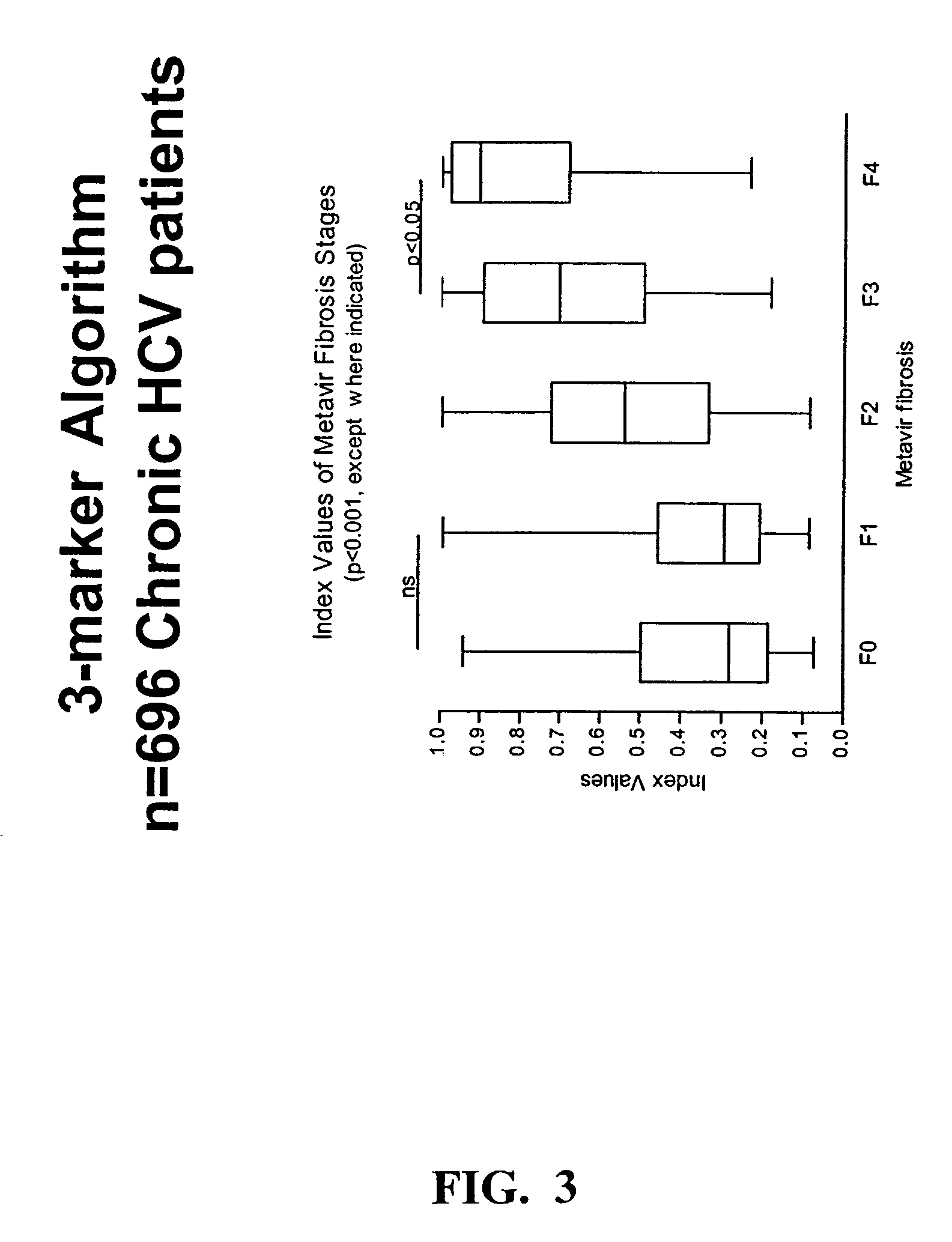Methods of diagnosing tissue fibrosis
a tissue fibrosis and tissue technology, applied in the field of fibrosis, can solve the problems of organ failure, liver disease or cancer end-stage, transplantation or death,
- Summary
- Abstract
- Description
- Claims
- Application Information
AI Technical Summary
Benefits of technology
Problems solved by technology
Method used
Image
Examples
example i
Assays for β2-Macroglobulin, Hyaluronic Acid and Tissue Inhibitor of Metalloproteinases-1
A. Quantitation of Human α2-Macroglobulin (α2-MG)
[0162]Serum levels of human α2-macroglobulin were quantitated using the Beckman Array.RTM. 360 System as follows to determine α2-MG levels in the range of 0.75-270 mg / ml.
[0163]The Beckman Array® 360 system was used for determination of α2-MG concentrations. This system utilizes a nephelometer which measures the rate of light-scatter formation resulting from an immunoprecipitation reaction between α2-MG antigen in a sample with antibody to human α2-MG. After passing a beam of light through the solution in a flow cell, the intensity of light scattered by the formed macromolecular particles of insoluble complexes suspended in solution is detected and measured by the nephelometer. The increase in light scatter resulting from the antigen-antibody reaction is converted to a peak rate signal proportional to the α2-MG concentration in the sample. The resu...
example ii
[0193]An algorithm was developed to differentiate no / mild from moderate / severe fibrosis in chronic HCV patients, as determined histologically from a liver biopsy, and staged using the Metavir system summarized in Table 2.
[0194]
TABLE 2MetavirFibrosisstageDescriptionNo / mildF0No fibrosisF1Stellate enlargement of portaltract without septa formationModerate / severeF2Enlargement of portal tractwith rare septa formationF3Numerous septa without cirrhosisF4Cirrhosis
[0195]Serum samples from 696 chronic HCV patients were obtained, at or near the time of liver biopsy, from 4 study sites. Levels of the three markers of fibrosis, hyaluronic acid (HA), tissue inhibitor of metalloproteinase-1 (TIMP-1), and α2-macroglobulin (α2M, or A2M), were determined in each specimen by protein binding assay (HA), ELISA (TIMP-1) and nephelometry (A2M). Severity of fibrosis in patients was staged by histological staining of a biopsy specimen using the Metavir system. These variables were subjected to regression an...
example 3
[0202]A second algorithm was determined using two markers: HA and TIMP1. The HA and TIMP1 levels from Example 2 were used in this algorithm. As for the three marker test above, sensitivity was maintained at 80%. Results are shown in Tables 5 and 6. With the two marker analysis and sensitivity of 80%, specificity of the test was 63.4%. In contrast, when A2M levels were analyzed with HA and TIMP1 levels as above, specificity of the test was 71.4%. Thus, addition of the A2M marker to the analysis improved the specificity of the test.
[0203]
TABLE 5F0F1F2F3F4Test+35888490115412Test−5615755133284Total91245139103118696
[0204]
TABLE 6F2-F4F0-F1TotalTest+289123412Test−71213284Total360336696Prev51.7%Sens80.3%Spec63.4%PPV70.1%NPV75.0%Accuracy72.1%
PUM
| Property | Measurement | Unit |
|---|---|---|
| pH | aaaaa | aaaaa |
| pH | aaaaa | aaaaa |
| time | aaaaa | aaaaa |
Abstract
Description
Claims
Application Information
 Login to View More
Login to View More - R&D
- Intellectual Property
- Life Sciences
- Materials
- Tech Scout
- Unparalleled Data Quality
- Higher Quality Content
- 60% Fewer Hallucinations
Browse by: Latest US Patents, China's latest patents, Technical Efficacy Thesaurus, Application Domain, Technology Topic, Popular Technical Reports.
© 2025 PatSnap. All rights reserved.Legal|Privacy policy|Modern Slavery Act Transparency Statement|Sitemap|About US| Contact US: help@patsnap.com



